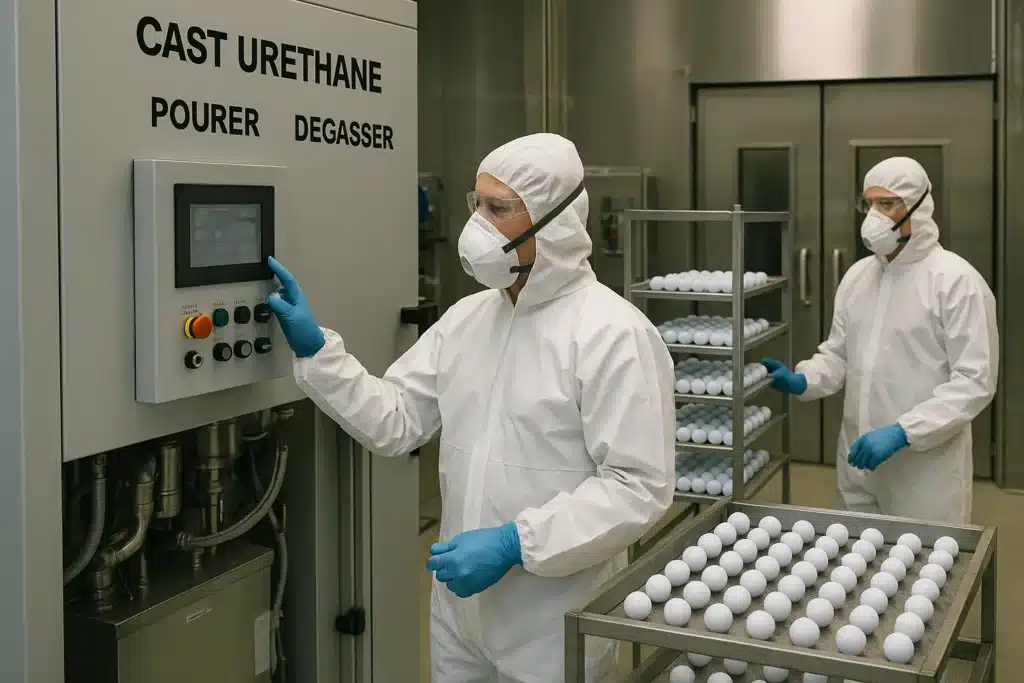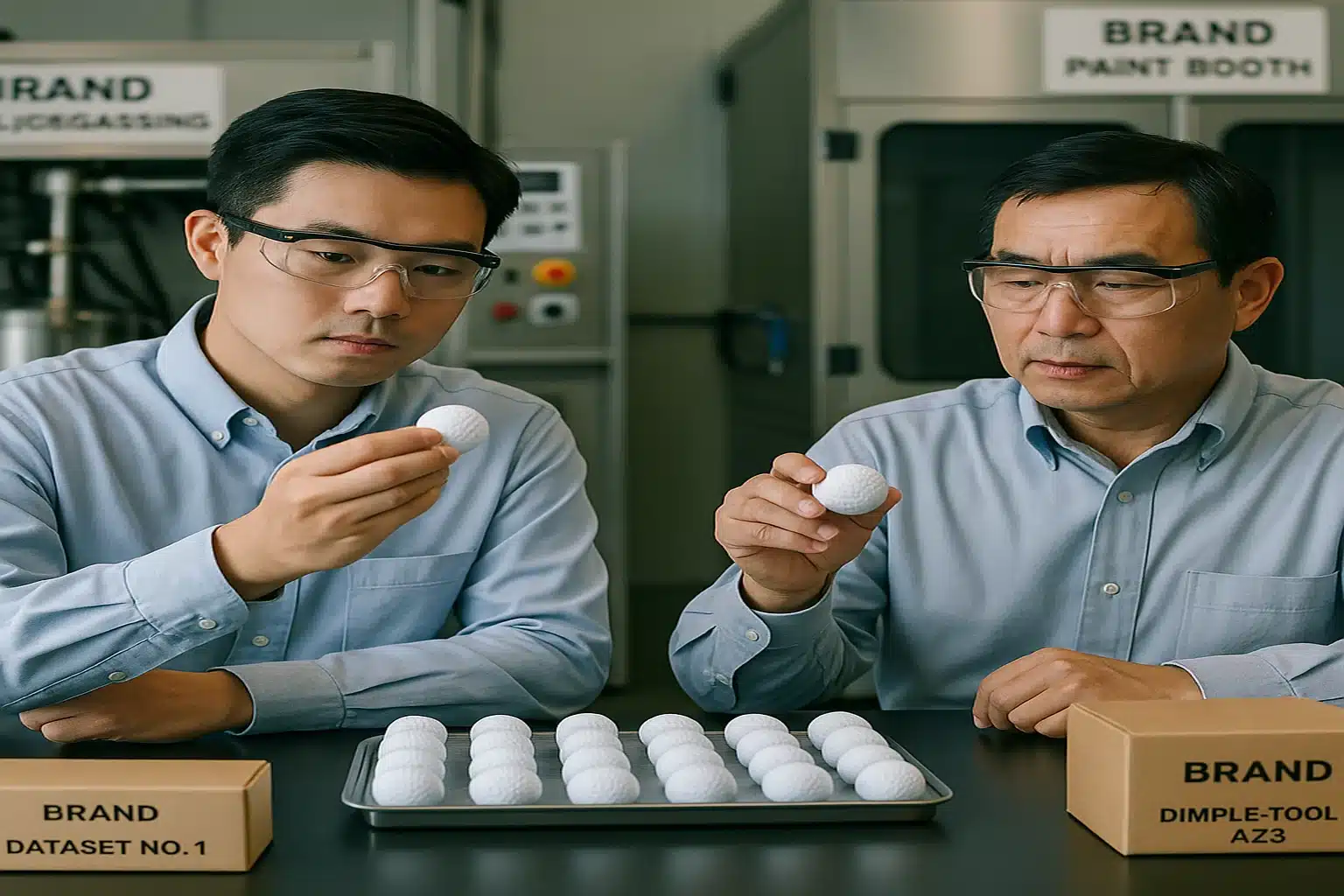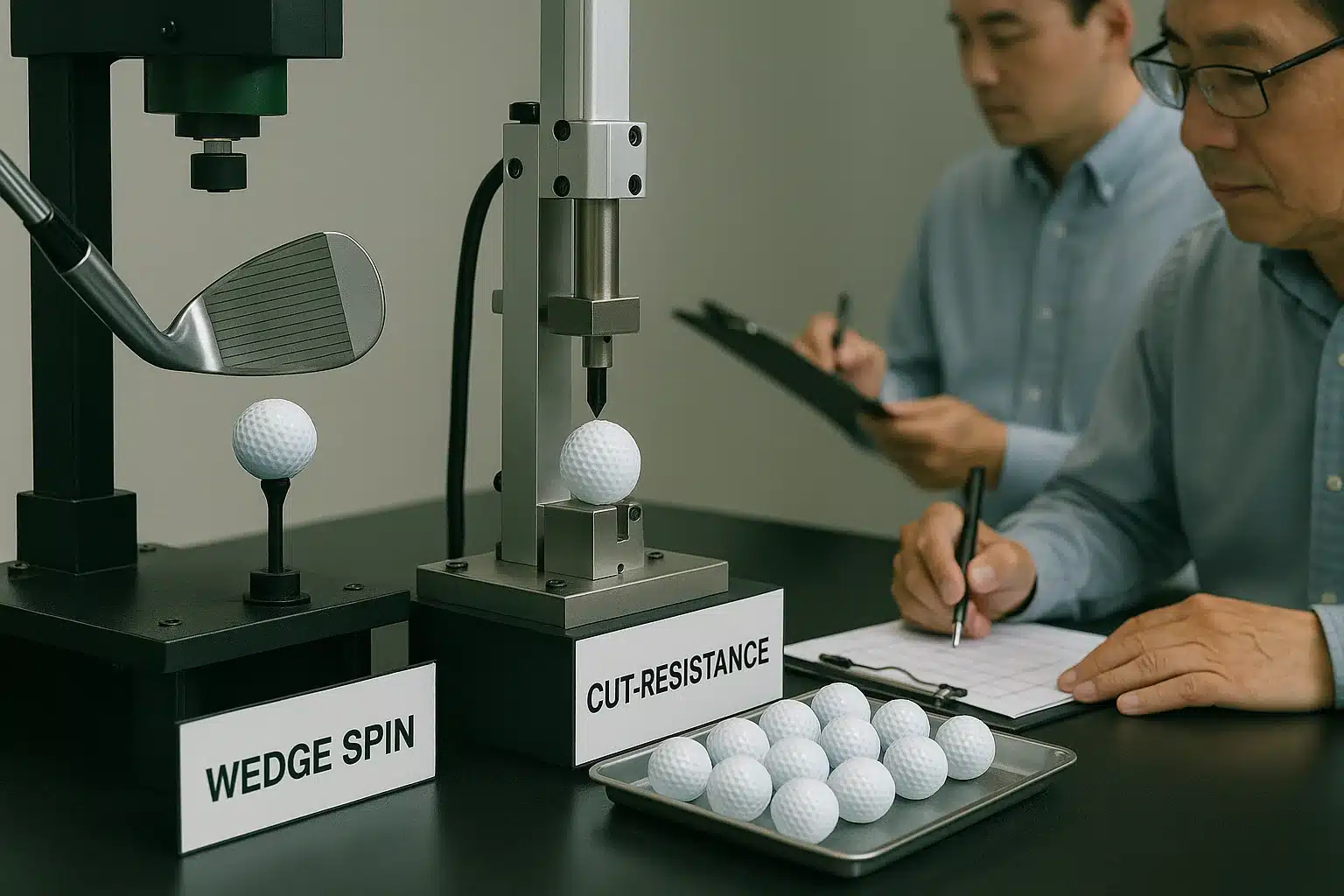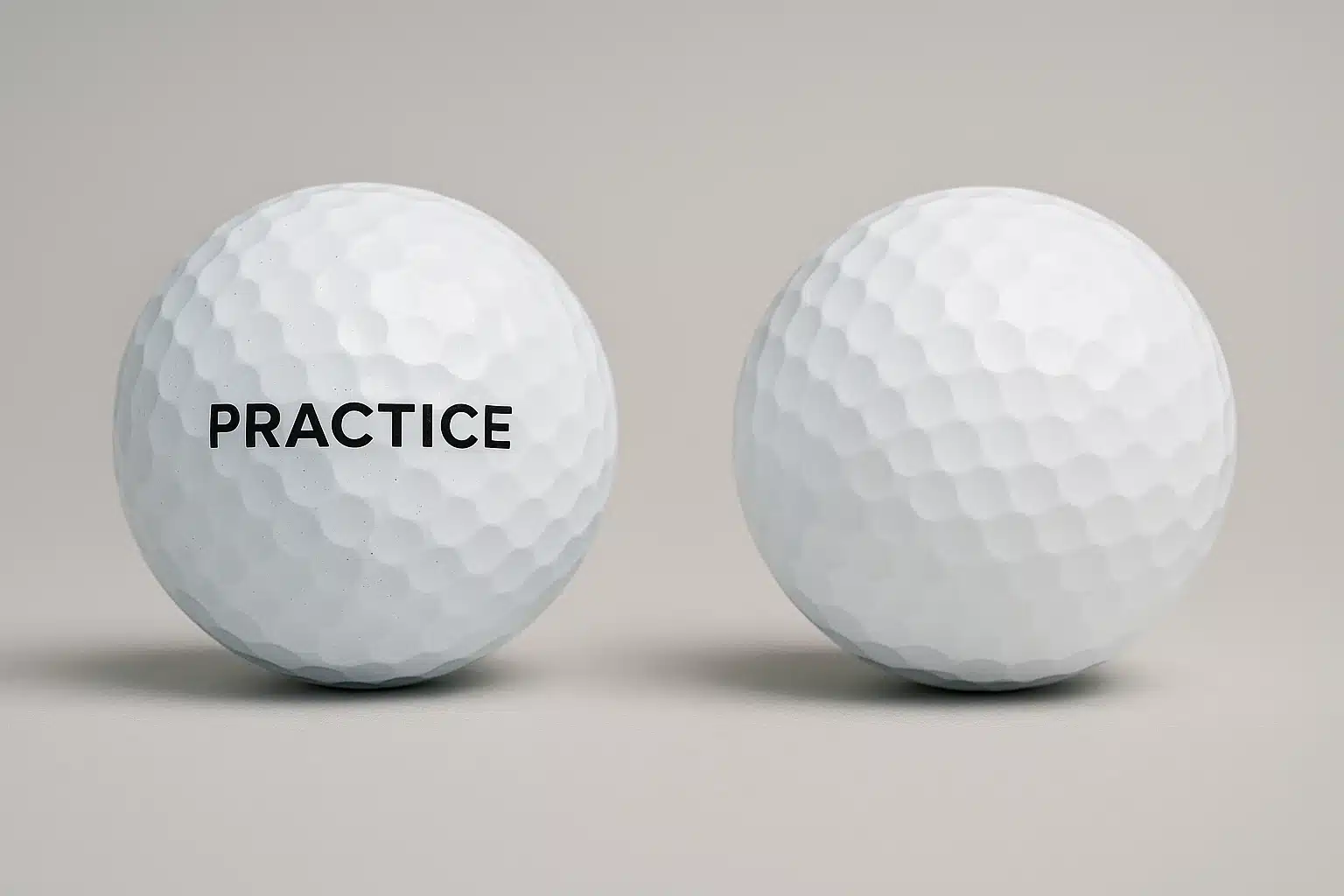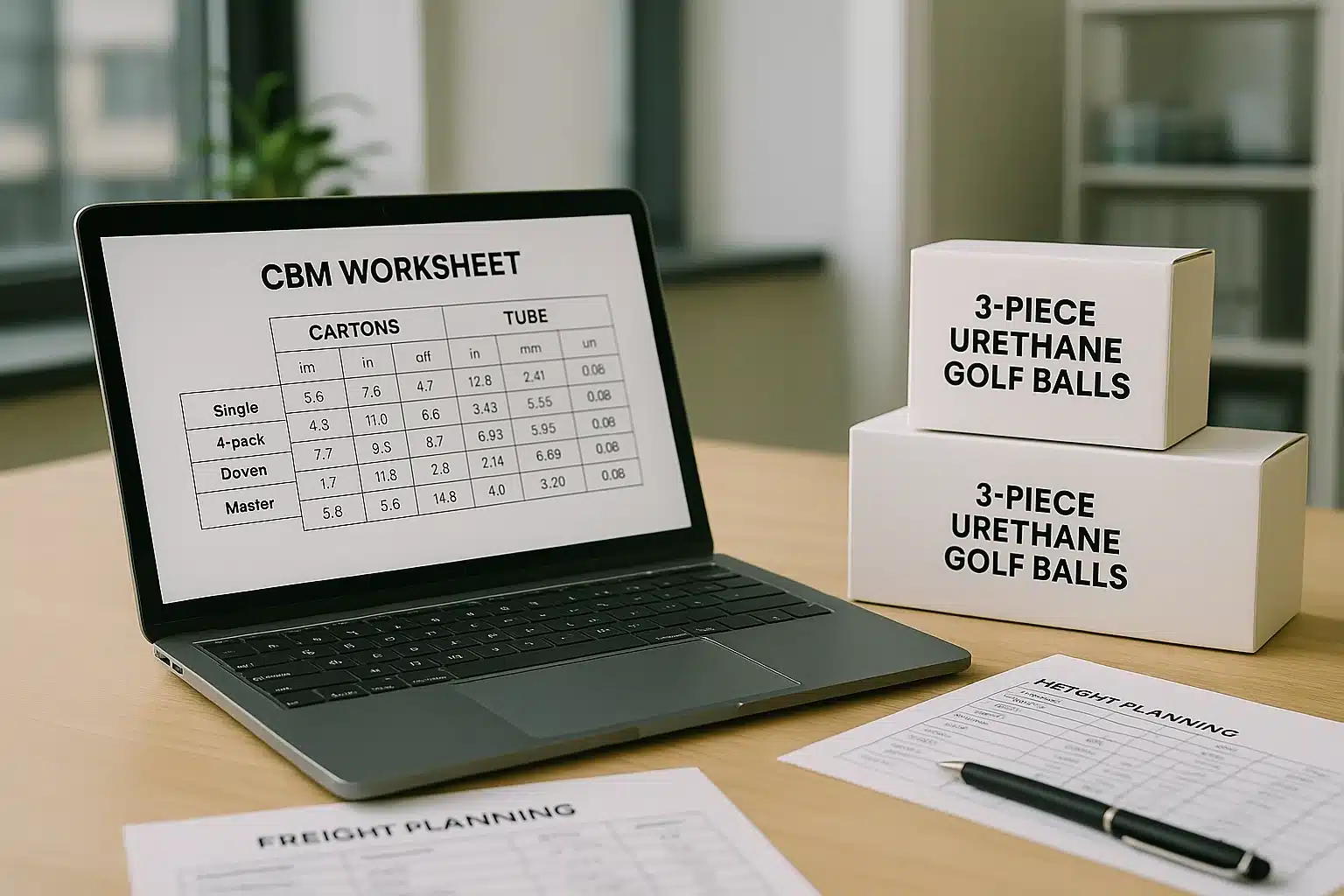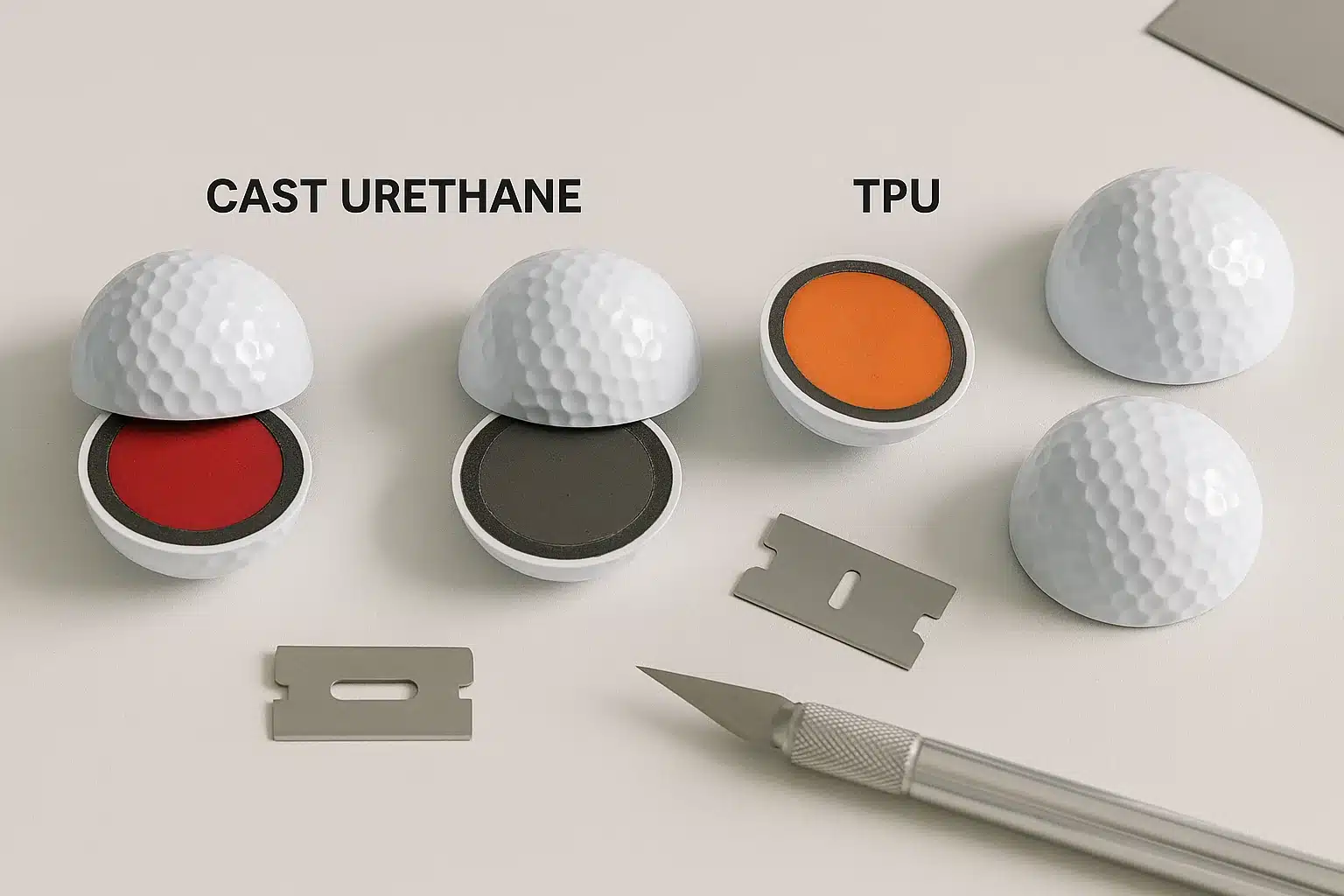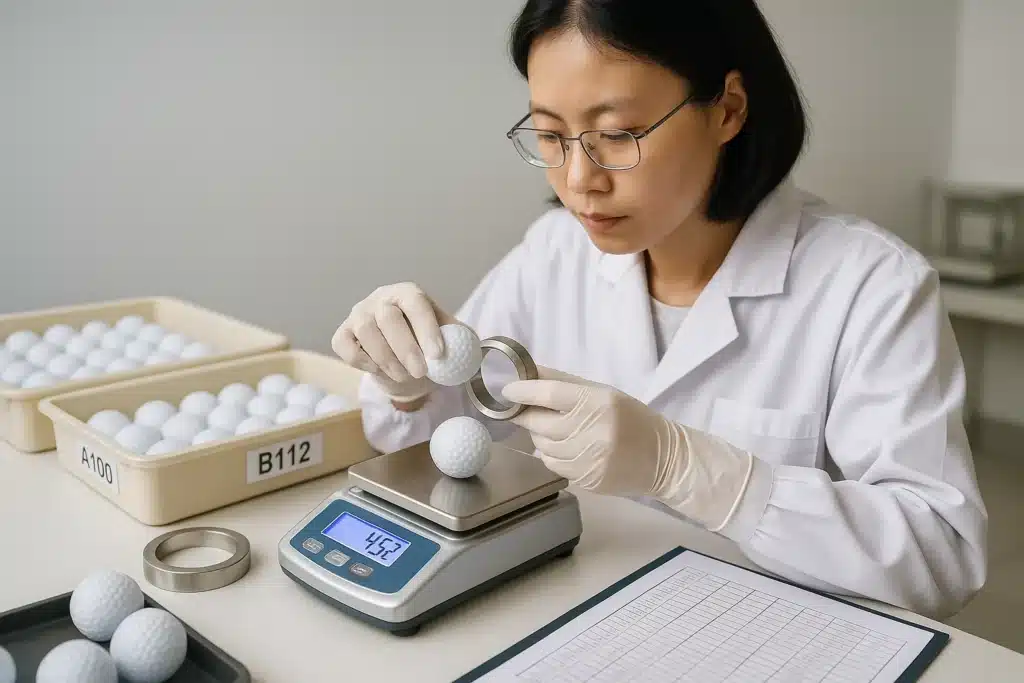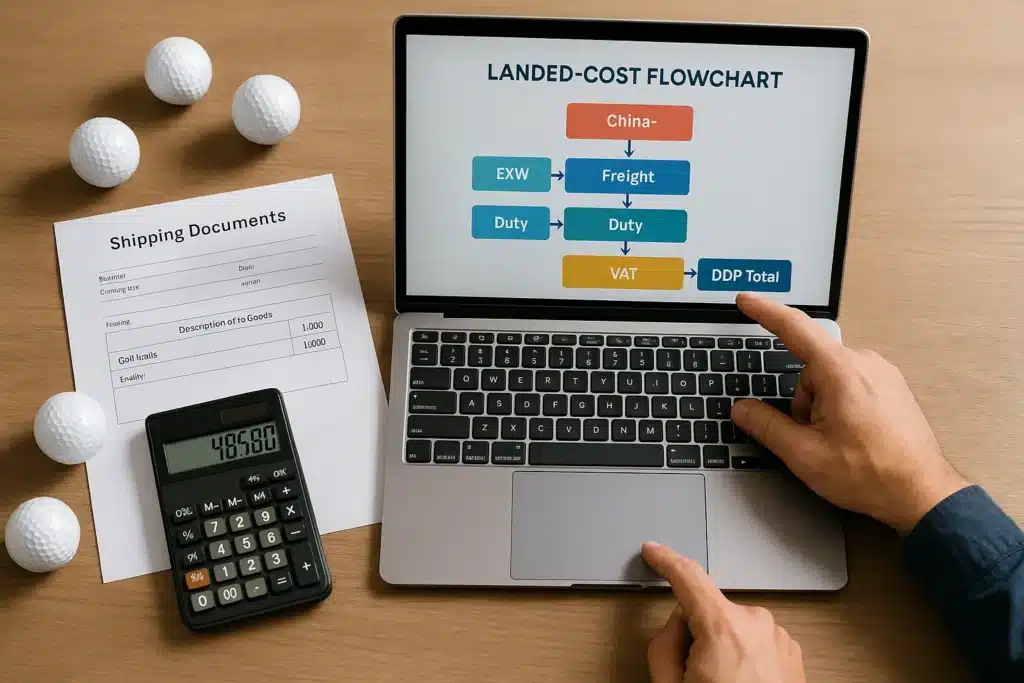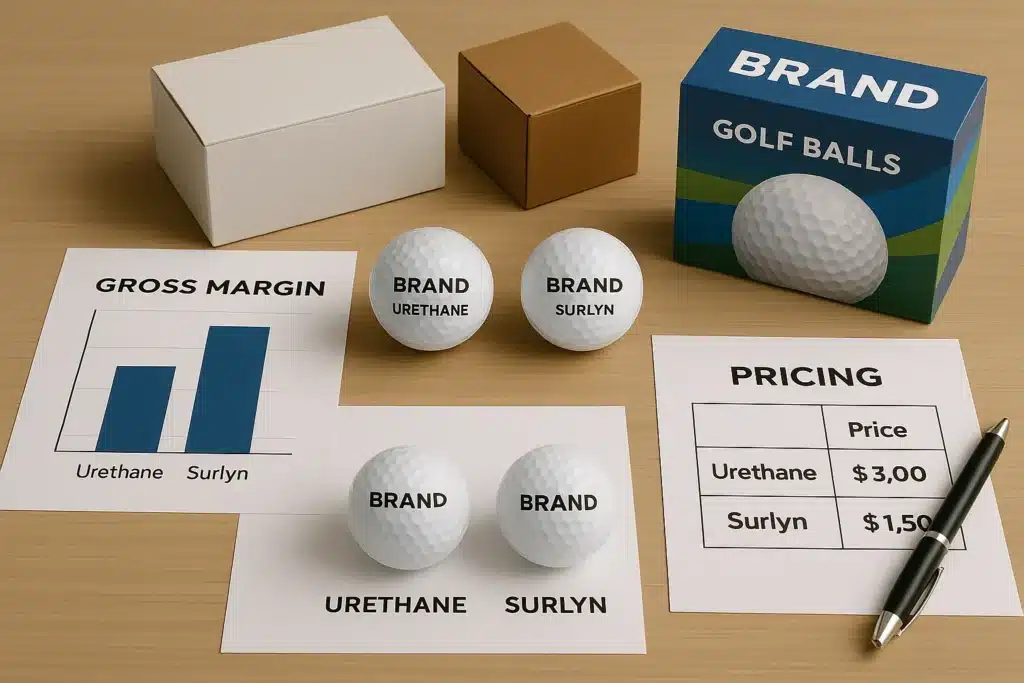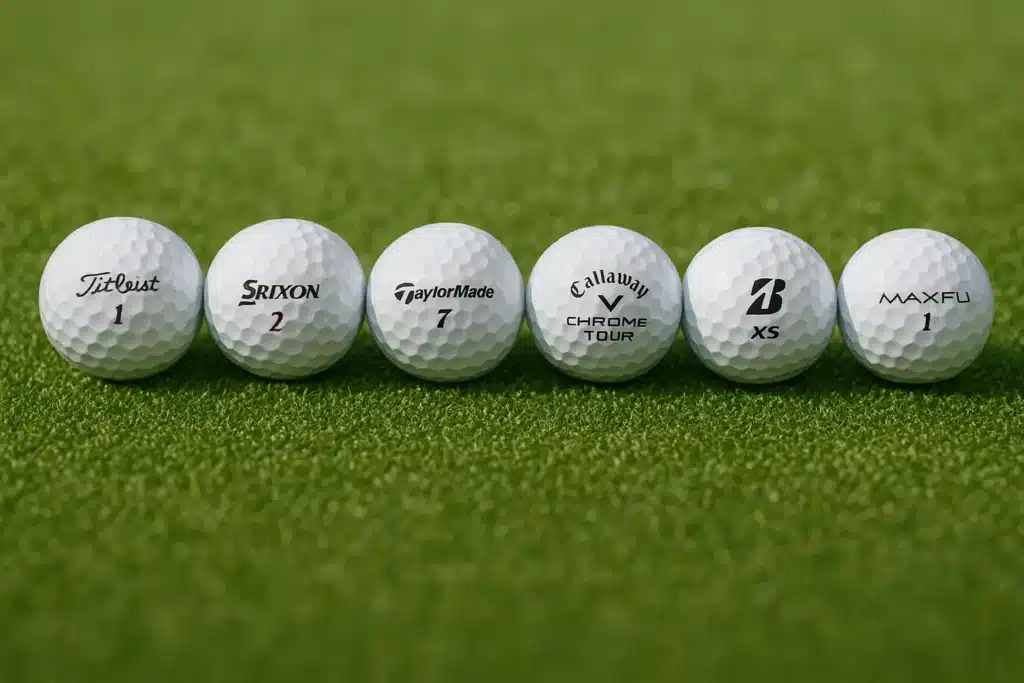China-based OEMs for 3-piece urethane golf balls include Xiamen JTS, Xiamen MLG, Ningbo Golfara, plus vetted Hangzhou/Shenzhen makers. MOQs typically 1,000–3,000. Sampling 10–20 days with existing tools/colors; mass 20–35 days after artwork and packaging lock.
| Factory | Typical spec | Common MOQ | Lead time (after approval) |
|---|---|---|---|
| Xiamen JTS | 3-piece urethane “tournament” builds | 2,000–3,000 | 20–30 days |
| Xiamen MLG | 2/3/4-piece incl. urethane | 2,000–3,000 | 20–30 days |
| Ningbo Golfara | 3-piece urethane | 1,000–3,000 | 10–20 days |
| Other qualified OEMs (Hangzhou/Shenzhen) | 3-/4-piece urethane | 1,000+ | 20–35 days |
Which Chinese factories truly mass-produce 3-piece urethane balls in 2025?
A practical shortlist begins with Xiamen JTS (visible ladder pricing), Xiamen MLG (custom 2/3/4-piece including urethane), and Ningbo Golfara (fast small-run timing), plus qualified Hangzhou/Shenzhen OEMs.
What capacity, urethane route, and QC evidence prove real capability?
Credible plants declare whether they run cast urethane, TPU, or both; show maintained 332/342/352 dimple tools; and share 24-ball datasets covering weight, diameter, roundness, initial velocity (IV)/COR, and compression. They label cartons with dimple-tool IDs and batch dates so dispersion stays traceable across lots.
Ask if cast urethane is a routine line or only for specials. Confirm TPU injection or compression press counts, cavity refurbishment intervals, and paint-line throughput (dozens per day). Require a weight reserve under 45.93 g after paint, not before. Request floor photos of mixing/degassing, casting or injection, paint booths, and pad printers that match catalog claims.
How do their dimple tools, mantle hardness, and feel targets differ?
Most maintain 332/342/352 families; a resurfaced 392 tool is fine if maintained. Mantle hardness sets launch and driver spin; urethane shell softness sets wedge spin and acoustics. Leading factories keep shell-thickness maps so aerodynamics and feel remain anchored to golden samples over long runs.
Ask for tool photos, polishing logs, and refurbishment dates. Request mantle durometer options (soft/mid/firm) and how they alter compression without drifting IV/COR. Seek sectioned-ball photos or X-ray outputs for concentricity. If a supplier refuses shell-thickness data, increase sampling frequency or select another partner.
Which private-label options scale reliably for brands and clubs?
You can use white or high-vis yellow, matte or pearl finishes, 1–3 logo colors, 3-ball sleeves with dozens, and gift boxes. Premium stacks—double-coat plus UV with multi-color registration—lift shelf perception but add unit cost and takt time; reserve booths and printers early.
Provide vector logos (AI/EPS), Pantone codes, and dielines at RFQ. For matte/neon, demand UV aging and detergent-rub tests on your exact paint stack. Weigh paint grams added and keep headroom under the weight cap. Align carton labels with your compliance checklist and ask for batch-dated master labels with tool IDs.
Why choose 3-piece urethane for OEM/private label?
Three-piece urethane pairs a tuned mantle with a urethane shell to balance distance with elite greenside spin and soft acoustics. For retail, club, and tournament programs, conformance and short-game control matter more than the rock-hard durability prized by range-biased ionomer balls.
How does urethane change spin, feel, and positioning versus ionomer?
Cast or TPU urethane typically lifts wedge spin and softens sound versus ionomer at the same compression. On shelves, “urethane” signals premium, supporting higher ASPs. You trade some scuff tolerance and throughput for control that better golfers feel from 50 yards and in.
Translate that into SKU strategy: one urethane flagship for premium channels and one ionomer value line for promotions and rough duty. Keep compression labels honest so shoppers understand the feel differences. In marketing, emphasize predictable check on chips, softer impact notes, and still-stable driver flight when the mantle is well-tuned.
Who gets the most value from 3-piece urethane programs?
DTC brands with performance stories, pro-shop and specialty retail, and clubs running frequent events gain most. Corporate gifts also benefit where recipients will feel the difference. Keep an ionomer SKU for bulk events, ranges, and very rough conditions.
Segment by audience and climate. Softer compressions (72–80) help colder markets and moderate swing speeds; firmer (85–90) supports higher speeds. If volume justifies it, run cast urethane for the flagship feel SKU and TPU urethane for value and speed-to-market. Ensure both share a visual language so replenishment remains flexible.
✔ True — Urethane elevates greenside spin and perceived quality
At equal compression, urethane covers—especially cast—deliver higher wedge spin and softer acoustics than ionomer. The trade is slightly slower takt and more delicate finishes, offset by stronger retail positioning and player satisfaction.
✘ False — “If compression matches, urethane and ionomer feel the same”
Compression is only one variable. Cover chemistry shifts friction and energy return, changing both spin windows and subjective feel.
How do “Practice” and play versions differ for 3-piece urethane?
In urethane, “Practice” typically marks cosmetic blemishes of the same conforming model—paint specks or minor print mis-registration—rather than a cheaper range build. The play version meets USGA/R&A lines; performance tracks retail, not a downgraded structure.
What’s the buyer-safe definition of “Practice” on urethane?
Treat “Practice” as a cosmetic stamp on conforming balls: same core, mantle, cover, and dimple pattern. Demand the same datasets—24-ball weight/diameter distributions, compression scatter, IV/COR—and the same labels with tool IDs and batch dates.
Ask which cosmetic defects trigger the stamp and whether AQL thresholds differ. Require retained samples for 6–12 months and COAs tied to invoice numbers. Communicate clearly to consumers: you’re trading paint perfection, not performance. Avoid selling urethane “Practice” as range stock; it’s uneconomical and risks cosmetic wear.
What conformance anchors and dispersion caps keep you safe?
Anchor to USGA/R&A: weight ≤45.93 g and diameter ≥42.67 mm. Then set internal caps for weight, diameter, roundness, compression, IV/COR, and paint grams added so you preserve mass headroom under the weight cap.
Make acceptance tables part of the PO. Ask for gauge R&R evidence. Keep shell-thickness maps for cast and knit-line controls for TPU. Store COAs with invoice folders so logistics, quality, and claims stay aligned.
| Dimension | “Practice” (label meaning) | Conforming play ball |
|---|---|---|
| Typical meaning | Cosmetic blemishes/print offset on the same model | Listed conforming; retail/tournament use |
| Structure/performance | Same 3-piece architecture and near-identical performance | Same model with full spec adherence |
| Use cases | Practice rounds, club sessions, budget-minded play | Formal competition, retail, club events |
✔ True — “Practice” in urethane is cosmetic, not structural
Unless stated otherwise, practice-stamped urethane balls share the same core, mantle, cover, and dimple pattern as retail. Keep identical QC datasets and traceable labels to ensure repeatable feel and flight.
✘ False — “Practice balls can skip batch data because they’re cheaper”
Dropping datasets invites variance. Buy statistical control for both SKUs so future lots behave like your pilots.
What lead times, MOQs, and prices should buyers expect in 2025?
Expect MOQs of 1,000–3,000 balls; sampling in 10–20 days when tools/colors exist; and mass production in 20–35 days after artwork lock. Cast urethane, double-coat + UV, multi-color logos, and gift boxes push toward the upper window.
Which levers move the FOB price band most?
Four drivers dominate: cover route (cast vs TPU), paint complexity (single vs double + UV), print color count/coverage, and packaging format. Tighter dispersion caps and batch testing add cost but reduce returns and strengthen retailer trust.
Ask for line-item quotes separating ball build from paint, print, and packaging. Compare shell-thickness targets and paint grams added. Maintain weight headroom under 45.93 g so minor paint variation won’t risk nonconformance. Budget $0.05–0.15/ball for strict QC—24-ball datasets, IV/COR summaries, and retained samples per lot.
How do sampling and mass schedules behave in peak season?
Sampling moves quickly with existing dimple tools and pigments; mass bottlenecks concentrate in paint booths and pad printers in Q2–Q3. Lock dielines early, freeze golden samples, and obtain written reservations for paint and print stations to protect ETD.
Sequence capacity booking: cover forming, then paint, then print. For matte/neon, run UV and 200–500-hit abrasion on the exact paint stack. If gift boxes are used, pre-approve mockups and barcodes. Allow buffer days for cure/post-cure; urethane dislikes rushed finishing and will punish schedules if corners are cut.
How should packaging and CBM shape your budget decisions?
CBM governs air and express freight. Fold-flat sleeves and dozens compress volume; tubes and blisters trap air and inflate dimensional weight. For sea, volume hurts less but still matters over pallets. Model landed cost per dozen before you choose format.
| Format | Typical inner | Dozens/carton | Approx CBM/dozen* | Notes |
|---|---|---|---|---|
| 3-ball sleeves + 12-ball box | 4 sleeves | 12 | 0.012–0.014 | Best for air/express; fold-flat components |
| Bulk white box (12) | 1 | 15–18 | 0.011–0.013 | Tightest packout; low labor |
| Tube (3) × 4 | 4 tubes | 8–10 | 0.014–0.017 | Round voids; strong retail look |
| Blister (2/3) | mixed | 8–12 | 0.015–0.018 | Highest DIM weight; finish care needed |
*Illustrative ranges; confirm with exact dielines and cartons.
✔ True — Model landed cost per dozen including CBM and air-lane realities
Freight is volume-driven. Tubes/blisters inflate CBM and can outweigh material savings; fold-flat sleeves/dozens compress volume for air/express. Compare sea vs. air and lock the format only after total landed-cost simulation.
✘ False — “Lowest EXW unit price wins regardless of freight”
Ignoring CBM and dimensional weight creates budget overruns. Volume, not grams, usually decides your real cost.
How do cast urethane and TPU routes change your plan?
Cast urethane enables thin, soft shells, premium greenside spin, and strong paint adhesion at slower takt and higher cost. TPU injection/compression runs faster and cheaper, often tougher, with a slightly firmer feel. Either meets spec if tools and QC cadence are disciplined.
What does cast urethane demand in mixing and curing?
Cast lines mix A/B components, degas, dispense into dimpled molds, then cure for minutes to tens of minutes per shot, followed by post-cure/cool control. Shell-thickness maps and concentricity checks keep flight consistent with golden samples.
Audit pot-life windows, temperature bands, viscosity checks, and vacuum-degassing steps. Review mold-polishing intervals and cavity refurbishment logs. Track paint grams added; compliance must come from geometry and mass, not heavy clear-coat. Increase sampling if you push thin shells for softer feel.
Where does TPU injection or compression shine?
TPU accelerates throughput and can improve cut/abrasion resistance, though feel is firmer at equal compression. Gate and knit-line management matter because flow lines that paint hides can still affect aero; keep weight reserve and preventive maintenance tight.
Ask for press tonnage, cavity counts, and preventive schedules. Inspect knit-lines before paint. Validate deflashing and post-process polishing. If you sell both cast and TPU variants, label clearly so golfers choose by feel rather than guessing about quality tiers.
How should catalog strategy balance cast and TPU?
Use cast urethane for flagships where feel and wedge spin define your brand; deploy TPU urethane for value or replenishment speed. Pilot both at 72/80/88 compression and pick by carry, dispersion, and feedback.
Keep the same dimple family to isolate cover effects. If matte/neon is mandatory, validate adhesion and scuff on your exact stack. For gift-heavy channels, cast urethane plus double-coat + UV wins hand-feel and gloss; for events, TPU can reduce lead time and damage risk.
✔ True — Cast urethane takes longer because cure and post-cure govern takt
Compared with TPU, cast requires mixing, degassing, precise shot control, cure, and post-cure. Paint then adds its own queues. Book both casting and paint booths early in peak months to protect ETD/ETA.
✘ False — “Once cores and mantles are ready, covers are equally quick”
Cover route dictates throughput. TPU is faster; cast yields softer feel and spin but needs scheduling discipline and buffer days.
FAQs
Is cast urethane always “spinier” than TPU at the same compression?
Generally yes for greenside spin and soft feel because cast allows thinner, softer shells with strong paint adhesion. But TPU can meet spec and feel good for many players—pilot both if you can support a two-tier catalog.
Test at 72/80/88 compression with the same dimple family to isolate the cover. If replenishment speed or rough handling matters, TPU may be right for events while cast anchors premium retail.
What compression fits roughly 90 mph drivers?
Aim for 80–85 as the safe center. Colder regions often prefer 72–80; higher swing speeds can accept 85–90. Build three pilots and choose by carry, dispersion, and player feedback—not by folklore alone.
Include sound in your evaluation; acoustics influence perceived feel. If low compression balloons for faster players, increase mantle hardness or pick a firmer target. For mixed markets, a single 82–84 SKU balances feel and flight.
Can matte neon urethane keep logos crisp without early scuff?
Yes if the paint stack, pigments, and pad inks are matched and validated. Demand UV aging, detergent rubs, and 200–500-hit abrasion on the exact stack; freeze the winning recipe into the golden set.
Matte sells on shelves but exposes handling flaws. Enforce glove handling at packout and corner boards on pallets. If chalking appears in pilots, adjust clear-coat chemistry or pigment set.
You might also like — Top 2-Piece Surlyn (Ionomer) Golf Ball Manufacturers in China (2025)

